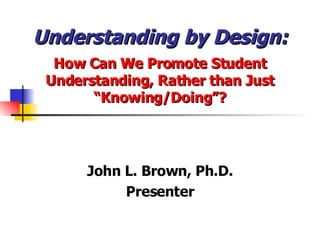
Promoting Student Understanding 2
- 1. Understanding by Design: How Can We Promote Student Understanding, Rather than Just “Knowing/Doing”? John L. Brown, Ph.D. Presenter
- 12. Another Way of Seeing It… Monday =the day after the day after tomorrow Sunday =the day after tomorrow Saturday =tomorrow Friday =TODAY Thursday =yesterday Wednesday =the day before yesterday. Tuesday =day before the day before yesterday.
- 21. Student Engagement: Some Commonly Identified Behaviors A Condition of “Flow” Understanding Rather than Memorization Seeing “the Big Picture” Transferability & Sustainability Ability to Set and Achieve Personal Goals Connections to the Student’s World Self-Monitoring & Regulation Sense of Authenticity and Purpose Motivation & Sense of Excitement
- 35. What Do Current Learning Theory and Research Tell Us? Creativity and “Flow” Brain-Compatible Teaching and Learning Emotional Intelligence The Constructivist Classroom Multiple Learning Styles, Modalities, and Intelligences Cognitive Learning Theory
- 57. To What Extent Is There Alignment in Your Curriculum? The Learned The Tested The Supported The Written The Taught The Ideal and the Organic
- 60. Curriculum as a System for Managing Learning (Susan Kovalik & Associates) Mastery/ Real-World Application : An ongoing goal for all learners. Immediate Feedback : Ongoing and multiple forms of assessment. Collaboration : All classrooms are genuine communities of learning and inquiry. Adequate Time : A core curriculum allows teachers to teach for depth, not coverage. Choices : Whenever possible, learners can help to shape their own learning decisions and focus. Enriched Environment : Learner-Centered and Experiential Movement Used to Enhance Learning Meaningful Content : Purpose and Authenticity Absence of Threat : Commitment to Nurturing Reflective Thinking for All Learners
- 72. The UbD “Three-Circle Audit” Process (pp. 78-79) Worth Being Familiar With... All Students Should Know and Be Able to Do... Enduring Understandings
- 75. Into Which Circle Would You Place the Following Learning Goals…? 9. Trace universal patterns, themes, and motifs common to art through the ages. (Humanities, Grade 12) 8. Identify key figures who contributed to the development of modern statistics. (College-Level Intro. to Statistics Course) 7. Describe eating patterns and menus from previous historical eras. (Health, Grade 4) 6. Interpret how a primary source document reflects political bias on the part of an author. (U.S. History, Grade 8) 5. Apply the habits of mind used by scientists to engage in scientific inquiry. (Science, Grade 5) 4. Explain how we can use the relationships between sounds and letters to make sense of text. (Reading, Grade 1) 3. Describe how a bill becomes law at state and national levels. (Civics, Grade 9) 2. Use the Periodic Table to identify the atomic weights of carbon, oxygen, and helium. (Chemistry, Grade 11) 1. Identify the years in which Mark Twain was born and died. (English, Grade 8)
- 133. Some Approaches to Differentiating Assessments Multiple Learning Modality Options Varied Journal Prompts Independent Study Anchored Activities and Varied Texts and Materials Curriculum Compacting Orbital Studies Cooperative Learning JIGSAWS Varied Homework Learning Contracts Aligning Products with Multiple Intelligences Interest Groups Tiered Centers Complex Instruction Interest Centers Tiered Lessons
- 136. The Analytic-Trait Rubric (P. 188) The performance or product is ineffective. Shows little apparent understanding of the relevant ideas and processes… 1 The performance or product is somewhat effective … Shows a somewhat naïve or limited understanding of relevant ideas or processes… 2 The performance or product is effective … Shows a solid understanding of the relevant ideas and processes… 3 The performance or product is highly effective … Shows a sophisticated understanding of relevant ideas and processes… 4 35 percent Weights: 65 percent Scale Performance or Performance Quality Understanding Traits